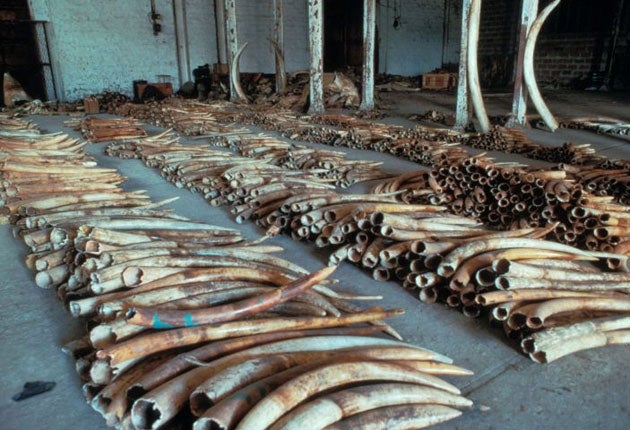Hong Kong’s ‘legal’ ivory trade thrives on folk beliefs and China’s rising wealth
“Millions of people who are getting into the middle class want to have a piece of ivory”

Hong Kong, this skyscraper-crowned metropolis of seven million, prides itself on its modernity. But on the third floor of Yue Hwa Chinese Products, a busy department store in Kowloon, the products for sale seem anything but modern. The glass display cases are full of Buddha figurines, lucky toad charms and dragon-shaped buttons, all carved from ivory, the tusks of dead elephants.
Ivory products are taboo in much of the world due to awareness of how poaching decimates elephant populations. But in a newly affluent China, owning ivory is seen by many as a sign of status. It’s described as “white gold”, both an object of desire and – increasingly – an investment vehicle.
“Millions of people who are getting into the middle class want to have a piece of ivory,” says Grace Ge Gabriel, the Asia regional director for the International Fund for Animal Welfare (Ifaw). “The world does not have enough elephants to supply that ivory.”
As the commercial gateway to China, Hong Kong is the throbbing heart of the global ivory trade. The city’s ceaselessly busy ports are a major point of entry for ivory smuggled from Africa to Asia. Customs officials have had to step up their detection game, uncovering larger and larger amounts of contraband ivory in recent years. In 2011, authorities seized 3,396kg of ivory. In 2012 they seized 5,596kg. This year, between January and October alone, they seized 7,230kg. Much more doubtless goes undiscovered, hidden inside shipping containers.
Murkier and more contentious is the issue of legal ivory. In Hong Kong, shops such as Yue Hwa have government-issued licences to sell certain types of ivory. These include ivory products carved before a 1989 ban on international ivory trade, ivory from the tusks of extinct mammoths, and ivory bought from government stockpile sales in Southern Africa. Licensed ivory stores are rife in Kowloon and along the Hollywood Road arts and antiques district on Hong Kong island. A 2011 survey counted 33,526 ivory items on display in 62 outlets.
But regulating the legal ivory market is complex and difficult. Despite certificates of origin, it is difficult to know whether supposedly legal ivory is genuinely pre-1989 or not, leaving the industry open to abuses. “These legal markets provide cover for illegal ivory to be laundered,” Ms Gabriel says.
And although ivory bought in Hong Kong cannot legally exit the city without a permit, this is not routinely enforced when it comes to tourists from the rest of China, who have enlarged the market for Hong Kong ivory to its breaking point. “It’s commonly expected that ivory will be bought by people from the mainland and taken to the mainland,” says Steven Gallagher, an associate professor of law at the Chinese University of Hong Kong. “No one really seems to be concerned.”
At Yue Hwa, two middle-aged tourists with shopping bags whispered excitedly to each other over a glass case of ivory chopsticks. While a set of decorative wooden chopsticks at Yue Hwa retails for about HK$300 (about £24), ivory sets cost upwards of $3,800. One of the many Chinese folk beliefs about ivory is that ivory chopsticks will change colour when they come into contact with poisoned food.
When asked whether the products could be legally taken out of Hong Kong, the salesman shook his head. But you could always “put it in your pocket”, he said with a smile.
Lately, stores have been hyping mammoth tusks as a virtuous ivory source. The tusks are dug from the icy Siberian tundra where they have lain buried for some 10,000 years, and shipped to Hong Kong.
Outside Prestige Crafts on Hollywood Road, a billboard extolls the virtues of mammoth ivory (“can be legally traded around the world”). Inside, mammoth tusks the size of tree trunks are carved with intricate designs of dragons, snakes and flowers, set atop white pedestals. The price tag on one particularly elaborate specimen: HK$23m (about £1.8m). But shopkeepers say elephant ivory is still more popular with Chinese customers.
Anti-ivory activists say many Chinese customers simply don’t understand ivory’s bloody origins. As many as 70 per cent of Chinese shoppers do not realise elephants must die to provide ivory, Ms Gabriel explains. The Chinese word for ivory literally translates to “elephant’s teeth”, which aids the misconception that tusks can fall out naturally. Ifaw has been working on a campaign to raise awareness about where ivory really comes from, plastering underground stations with posters featuring a heart-wrenching scene of a mother elephant and her baby.
In October, Hong Kong activists protested outside Chinese Arts and Crafts, a major purveyor of ivory products, holding signs with pictures of bloodied elephant corpses. One of the protesters was Christina Seigrist, the eight-year-old great-great-granddaughter of the Chinese nationalist revolutionary Sun Yat-sen. If Chinese customers knew how smart and loving elephants were, Christina says, and understood how ivory poaching harmed them, perhaps they would stop patronising Hong Kong’s ivory shops.
“I think they would not buy ivory,” she says, “because they would know it was from an animal’s life.”

Join our commenting forum
Join thought-provoking conversations, follow other Independent readers and see their replies